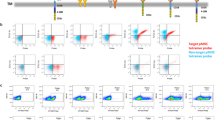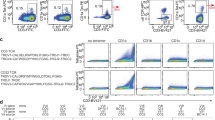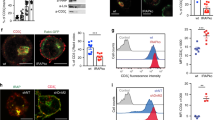Abstract
TYPE III receptors for IgG (FcγRII; ref. 1), high-affinity IgE receptors (FcɛRI; ref. 2), as well as the T- and B-cell antigen receptors3,4, consist of multiple components with specialized ligand-binding and signal transduction functions5–10. FcγRII α (ligand-binding) and γ (signal-transducing) subunits are expressed in macrophages1, a cell type involved in the uptake of antigen, its processing and the presentation of the resulting peptides to major histocompatibility complex class II-restricted T lymphocytes11,12. Here we show that murine FcγRIII, transfected into FcγR-negative antigen-presenting B-lymphoma cells, mediate rapid ligand internalization and strongly increase the efficiency of antigen presentation when antigen is complexed to IgG. Efficient internalization and antigen presentation via FcγRIII did not require the cytoplasmic domain of the ligand-binding α-chain, but did require the γ-subunit. Using chimaeric molecules, we show that γ-chain contains a signal for receptor internalization and that the mutation of either of the two ryrosine residues present in its cytoplasmic domain prevents efficient internalization and antigen presentation of immune complexes. Thus, associated chains and their tyrosine-containing motif are not exclusively involved in cell activation, but also determine multimeric receptor internalization.
This is a preview of subscription content, access via your institution
Access options
Subscribe to this journal
Receive 51 print issues and online access
$199.00 per year
only $3.90 per issue
Buy this article
- Purchase on Springer Link
- Instant access to full article PDF
Prices may be subject to local taxes which are calculated during checkout
Similar content being viewed by others
References
Ravetch, J. V. & Kinet, J-P. A. Rev. Immun. 9, 457–492 (1986).
Metzger, H. et al. Rev. Immun. 4, 419–470 (1986).
Klausner, R. D., Lippincott-Schwartz, J. & Bonifacino, J. S. A. Rev. Cell Biol. 6, 403–431 (1990).
Venkitaraman, A. R., Williamsm, G. T., Dariavach, P. & Neuberger, M. S. Nature 352, 777–781 (1991).
Klausner, R. D. & Samelson, L. E. Cell 64, 875–878 (1991).
Irving, B. A. & Weiss, A. Cell 64, 891–901 (1990).
Nomura, J., Matsuo, T., Kubota, E., Kimoto, M. & Sakaguchi, N. Int. Immun. 3, 117–126 (1991).
Wegner, K. et al. Cell 68, 83–95 (1992).
Letourneur, F. & Klausner, R. D. Science 255, 79–81 (1992).
Bonnerot, C. et al. EMBO J. 11, 2747–2758 (1992).
Unanue, E. R. A. Rev. Immun. 2, 395–428 (1984).
Lanzavecchia, A. A. Rev. Immun. 8, 773–793 (1990).
Jones, B., Tite, J. P. & Janeway, C. A. Jr J. Immun. 136, 348–356 (1986).
Trowbridge, I. S. Curr. Opin. Cell Biol. 3, 634–641 (1991).
Ksitakis, N. T., Thomas, D'N. & Roth, M. G. J. Cell Biol. 111, 1393–1407 (1990).
Unkeless, J. C. J. exp. Med. 150, 580–596 (1979).
Amigorena, S. et al. Science 256, 1808–1812 (1992).
Justement, L. B., Kreiger, J. & Cambier, J. C. J. Immun. 143, 881–889 (1989).
Drake, J. R., Repasky, E. A. & Bankert, R. B. J. Immun. 143, 1768–1784 (1989).
Iserky, C., Rivera, J., Segal, D. M. & Triche, T. J. Immun. 131, 388–396 (1983).
Chu, G., Hayakawa, H. & Berg, P. Nucleic Acids Res. 15, 1311–1326 (1987).
Salamero, J., Humbert, M. Cosson, P. & Davoust, J. EMBO J. 9, 3489–3496 (1990).
Breyer, R. M. & Sauer, R. T. J. biol. Chem. 264, 13348–13353 (1989).
Lai, M.-Z. et al. J. Immun. 139, 3973–3979 (1987).
Fracker, P. J. & Spreck, J. C. Biochem. biophys. Res. Commun. 80, 849–857 (1978).
Haigler, H. T., Maxfield, F. R., Mark, C. W. & Pastan, I. J. biol. Chem. 4, 1239–1241 (1980).
Author information
Authors and Affiliations
Rights and permissions
About this article
Cite this article
Amigorena, S., Salamero, J., Davoust, J. et al. Tyrosine-containing motif that transduces cell activation signals also determines internalization and antigen presentation via type III receptors for IgG. Nature 358, 337–341 (1992). https://doi.org/10.1038/358337a0
Received:
Accepted:
Issue Date:
DOI: https://doi.org/10.1038/358337a0
This article is cited by
-
The role of IgG Fc receptors in antibody-dependent enhancement
Nature Reviews Immunology (2020)
-
Maternal immunization with ovalbumin or Dermatophagoides pteronyssinus has opposing effects on FcγRIIb expression on offspring B cells
Allergy, Asthma & Clinical Immunology (2014)
-
The function of Fcγ receptors in dendritic cells and macrophages
Nature Reviews Immunology (2014)
-
Maternal immunization with ovalbumin prevents neonatal allergy development and up-regulates inhibitory receptor FcγRIIB expression on B cells
BMC Immunology (2010)
-
Endocytosis of FcαR is clathrin and dynamin dependent, but its cytoplasmic domain is not required
Cell Research (2010)
Comments
By submitting a comment you agree to abide by our Terms and Community Guidelines. If you find something abusive or that does not comply with our terms or guidelines please flag it as inappropriate.



